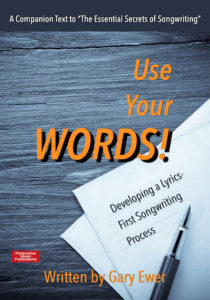I firmly believe that checklists should only be used in songwriting if you know that something’s wrong. In other words, if you’ve written a song and you really like it, a checklist will serve no purpose other than to make you second-guess what you’ve written, and that’s never helpful.
 Chapter 5 of “The Essential Secrets of Songwriting” deals with how great melodies work, and shows you how to write tunes that partner up well with your lyrics. Right now, “Use Your Words! Developing a Lyrics-First Songwriting Process” is free with your purchase of the bundle.
Chapter 5 of “The Essential Secrets of Songwriting” deals with how great melodies work, and shows you how to write tunes that partner up well with your lyrics. Right now, “Use Your Words! Developing a Lyrics-First Songwriting Process” is free with your purchase of the bundle.
But if you’ve written a song and you feel that there’s something wrong, and you’ve traced the problem to being something wrong with the melody, try this checklist. It will hopefully give you some ideas you can use to get the melody working for you.
With this checklist, you should be able to answer “yes” to most questions, but keep in mind: because music is an art, a “no” doesn’t mean that there’s a problem, but it does give you an idea for what might be at issue:
VERSE MELODY
- Your verse melody starts relatively low in pitch when compared to the rest of the song. (This difference in range only needs to be slight.)
- Your verse melody gradually works its way upward as it approaches the chorus (unless it connects to a pre-chorus).
- Your verse melody might have a pleasant “wandering” quality.
- Your verse melody should have repeated ideas — short repeated ideas like repeated notes or pairs of notes, as well as repeated phrases.
CHORUS MELODY
- Your chorus melody contains a noticeable, catchy hook, one that defines the song to the listener. (Often the chorus will start with that hook.)
- Your chorus melody is rhythmically “locked in”, using fairly simple melodic rhythms.
- Your chorus melody is tonally simple but strong, supported by a strong chord progression that makes the key of the song clear.
- Your chorus melody sits higher in pitch than your verse melody. (This difference in range only needs to be slight.)
- Your chorus melody works well as a repeated section; the end of the chorus connects easily back to the beginning.
- There is a “fun” aspect to singing the chorus.
PRE-CHORUS MELODY (Optional)
- Your pre-chorus melody moves higher and connects smoothly to the chorus.
- Your pre-chorus melody sounds different from the verse melody, offering a sense of variety.
- Your pre-chorus melody should be supported by chords that move smoothly into the chorus progression.
BRIDGE MELODY (Optional)
- Your bridge melody should highlight (or even move into) a different key from the chorus.
- Your bridge melody should be different from verse and chorus melodies.
- Your bridge melody might feature a climactic moment higher than whatever high point you have in your chorus melody.
As you put the magnifying glass on your melodies, remember that all good songs are a partnership of elements, all cooperating to better each other. So melodies are only part of the story. The lyrics you add to those melodies, and the chords you use to support the melodies, all play a vital role.
But if you’re sure that weakness in your song comes from the melodies you’ve written, this checklist might get you at least looking in the right direction.
 Written by Gary Ewer. Follow Gary on Twitter.
Written by Gary Ewer. Follow Gary on Twitter.
 Are you ready to have LYRICS take a much more important role in your songwriting process. You need to read “Use Your Words! Developing a Lyrics-First Songwriting Process.” Right now, it’s FREE with your purchase of “The Essential Secrets of Songwriting 10-eBook Bundle”
Are you ready to have LYRICS take a much more important role in your songwriting process. You need to read “Use Your Words! Developing a Lyrics-First Songwriting Process.” Right now, it’s FREE with your purchase of “The Essential Secrets of Songwriting 10-eBook Bundle”










